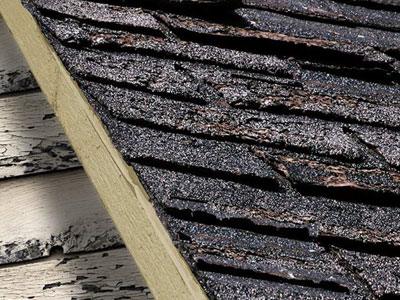
Key Danger Signals
Don't get caught with sudden, costly repairs. Keep a close eye on your roof and find out how to spot problems - including these 7 key danger signs - before they severely impact your wallet.A leak in the attic.
After a strong storm or wind-driven rain, take a look in the attic for signs of leaking. It could indicate damaged shingles, inadequate underlayment or deteriorated flashing.

Blistering or peeling interior or exterior paint.
Moisture trapped in the house due to poor ventilation can cause exterior paint to peel and blister.
Stains on interior ceilings and walls - mold or mildew growth.
Stains, or worse, mold, can be caused by leaks from outside the house or moisture trapped inside.

Exterior decay in sheathing and/or siding.
Excess moisture can also contribute to decay.


Missing, cracked, or curled shingles.
Dry, cracked, or easily broken shingles have reached the end of their useful life, and its time to invest in a new roof.
Dark, dirty-looking areas on your roof.
Vegetation, fungus, mold, or algae growth can cause dark stains on your shingles. That doesnt necessarily mean you need a new roof, but if you do choose to replace your shingles, ask for StainGuard protection available on many GAF Shingles, including Timberline Cool Series Shingles, Timberline Natural Shadow Shingles, Timberline ArmorShield II Shingles, and Timberline Ultra HD Shingles.
(StainGuard protection is available only on shingles with StainGuard -labeled packaging. See GAF Shingle & Accessory Ltd. Warranty for complete coverage and restrictions.)


Excessive energy costs.
Inadequate ventilation can possibly drive up your household cooling costs by trapping hot air in the attic. Attic moisture can also drip into your insulation, reducing its effectiveness.
How to Inspect for Damage
Why wait for the drip, drip, drip of a damaged roof Its a good idea to inspect your roof regularly, particularly if you live in areas of the country that experience extreme weather. You can inspect your roof yourself by either climbing on your roof or by using binoculars from the ground.If you choose to go up on the roof yourself, remember to always utilize proper safety equipment to prevent falls or injury. See our Safety section for more details.
Here are some things to look for:
- Check flashing for damage or inadequate coverage
- Look under eaves and overhangs for damage
- Examine shingles for any that are missing, cracked, curled, torn, or warped
- Look for any open seams or joints
- Look for popped or rusted nails or stains around nails
- Look for signs of insects or critter infestation (squirrels love climbing on roofs)
- Check for sagging or unsound areas
- Check for rotten fascia and eaves
- Inspect your sources of roof ventilation to make sure they are not clogged
- Inspect gutters for sagging or signs of leaks and be sure to remove any leaves or debris
- Check for dark patches or biological growth
- Check around pipes and roof penetrations to make sure they are sealed and in good shape there shouldnt be any exposed nails around flashings (if so, they should be sealed)
- Look inside the attic for signs of leaks, dark spots, holes, or sagging sheathing
You can do all this yourself, but if youre uncomfortable with the idea of walking around on your roof or climbing a ladder in the first place, or you just want a professional inspection done, your best option is always to find a GAF factory-certified Master Elite Contractor near you.
